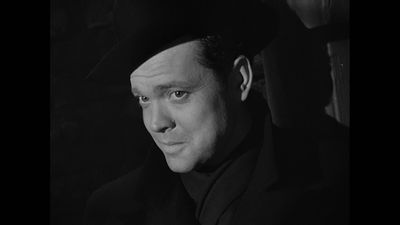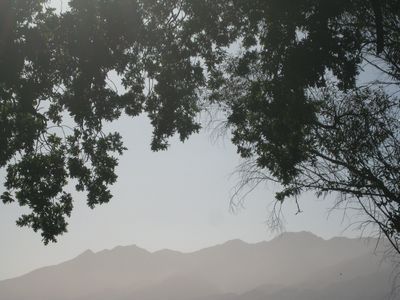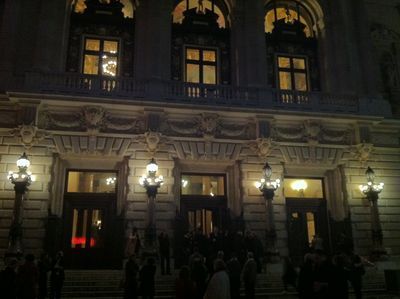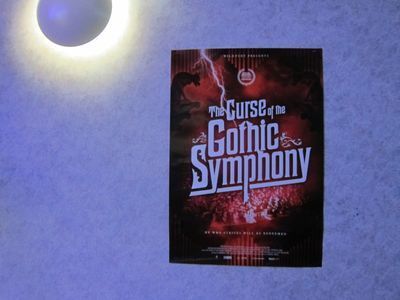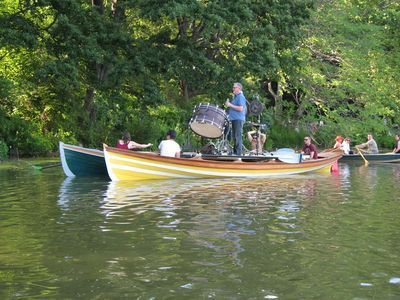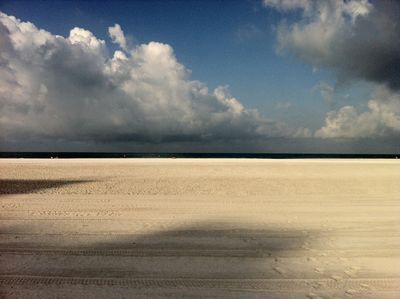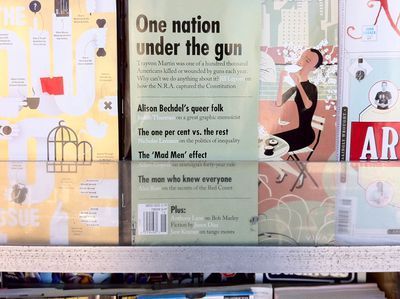Alex Ross's Blog, page 194
April 26, 2012
Where would you put Mr. James Joyce?
Lists are dumb, but they have a certain persuasive power. I remember poring over a list of the Ten Greatest Films of All Time that Roger Ebert included in one of his video guides of the nineteen-eighties: it led me to Aguirre, Wrath of God, Errol Morris's Gates of Heaven, and the film that will forever head my personal list — The Third Man. Roger, a writerly hero of mine, dislikes making such lists, but acquiesces in the drill when the proprietors of the Sight and Sound poll come calling. This time, with his customary devotion to the visionary impulse, he has added The Tree of Life. No one is asking me, but I'd be tempted to vote, after the above, for Andrei Rublev, Vertigo, Chinatown, Touch of Evil, Playtime, The Godfather Part II, La Dolce Vita, and The Passion of Joan of Arc. That's only nine; I want to think about The Tree of Life a little longer.
Ojai 2013
From an Ojai Festival press release: "[Mark] Morris will present his extraordinary Mark Morris Dance Group in a two-part evening of dance to the music of Samuel Barber, Igor Stravinsky, Lou Harrison, Henry Cowell, and Charles Ives. Mr. Morris will lead an evening of social dancing, and will narrate Sir William Walton’s Façade, a highly entertaining series of musical settings to verses by Dame Edith Sitwell. There will be a late-night concert of music by John Cage. Emanuel Ax and Yoko Nozaki will perform a two-piano recital featuring Olivier Messiaen’s haunting Visions de l’Amen. One program will feature Lou Harrison’s Suite for Symphonic Strings and John Luther Adams's evocative For Lou Harrison. The trio The Bad Plus will perform its own highly original version of Stravinsky’s The Rite of Spring. The Festival will conclude with a two-part concert that features Lou Harrison’s Concerto for Organ and Percussion, Henry Cowell’s transfixing Atlantis, and Lou Harrison’s Concerto for Piano and Gamelan." Yes.
Kessler on music
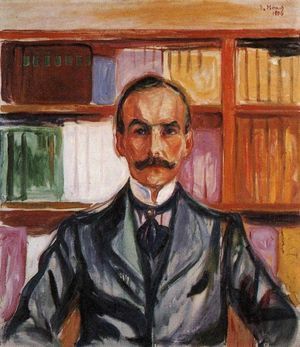
A portrait of Kessler by Edvard Munch.
In last week's New Yorker, I wrote about Journey to the Abyss, Laird Easton's English translation of the early diaries of Count Harry Kessler. As promised, I have typed up some music-related passages from the diaries — namely, Kessler's dinner with Mahler; the origins of Der Rosenkavalier; Shaw on Mozart; the androgynous Schoenberg-Nijinsky ballet that never was; the premiere of The Rite of Spring; a glimpse of Richard Strauss's anti-war stance during World War I; and the Mahler performance in Zurich that seemed to herald world revolution. There are more musical gems to be found in the diaries, which, in a better world, would have been a runaway bestseller.
March 18, 1907, Vienna:
Sat with the Mahlers in the loge for the premiere of Iphigenie in Aulis. Afterward stayed up late at Hartmann's with the Mahlers, the Molls, Burchardt, etc. Someone said that good art is never popular. I replied, "Not true! For example, Wagner." Then someone asked why certain great artists had found a public and others not. Mahler said that with Wagner it was because he had been the first great composer who painted nature. The romantics, Weber, etc., made a beginning, but Wagner had carried this to completion. With him as in nature everything remains in flux. Nowhere is there a conclusion, nothing returns in exactly the same way as in earlier music. This is what distinguishes post-Wagnerian, modern music above all from pre-Wagnerian music. One brings back the same motifs, to be sure, but in a completely new performance [Kessler writes Durchführung; "development" might have been preferable]. So you can avoid boring the public and you have the same flux as in reality.
Feb. 9, 1909, Weimar:
Lunched alone with the Hofmannsthals. Rode out with Helene Nostitz to Tiefurt and went for a walk in the snow-covered park. Hofmannsthal asked me about Claude Terrasse's Travaux d'Hercule, which Elias described to him so well. In conclusion I told him about Terrasse's Faublas operetta. Hofmannsthal was enchanted. That is precisely what he would like to write for Strauss. He wanted to take that up immediately and see if there was something there. If it worked then he had enough material for years. With the money that such a merry comic opera would earn him and Strauss he would be able to educate all his children. He would then be much freer to create other things.
Feb. 10, 1909:
[After Hofmannsthal and Kessler thrash out the scenario, with many of the best ideas coming from Kessler:] So Faublas and Pourceaugnac [aka Octavian and Baron Ochs] stand opposed to each other not only as youth and age, beauty and ugliness, bad and good manners, but also as clumsiness and esprit. This antithetical quality is perceived clearly. As in the world stupidity is the driving force, which esprit, however, makes use of.
Jan. 9, 1912, London:
Had lunch at Bernard Shaw's ... About Mozart, Shaw said that he had kept his music flowing by little impulses, sforzando passages, "little kicks." When the completely different, broad melodies of Beethoven and Wagner arose, conductors played Mozart as well in this style and killed him. Only Richard Strauss, whose style is related to Mozart's, rediscovered the correct style to present Mozart.
Feb. 19, 1913, London:
Craig and Diaghilev and Nijinsky had lunch with me so that we could agree on a ballet. Craig proposed as an idea that Nijinsky should appear in the same ballet sometimes as a man and sometimes as a girl. He should embody the ideal figure of the woman. Diaghilev wanted Schönberg to compose the music. He and Nijinsky believe that Schönberg's ultramodern, peculiar manner was as if made for the fantastically poetic subject. Craig was, when I translated their view to him, completely crushed, because one thinks of his work as "strange" and ultramodern. "I had hoped I was quite normal and traditional." That's why he prefers Vaughan Williams as a composer.
May 29, 1913, Paris:
In the evening the premiere of The Rite of Spring. A completely new choreography and music. Nijinsky's dancing style as different from Fokine's as Gauguin's from _____ [Laird Easton's note: "Kessler wrote 'Delacroix' and then crossed it out"]. A thoroughly new vision, something never before seen, enthralling, persuasive, is suddenly there, a new kind of wildness, both un-art and art at the same time. All forms laid waste and new ones emerging suddenly from the chaos. The public, the most elegant house I have ever seen in Paris — aristocracy, diplomats, the demimonde — was from the beginning restless, laughing, whistling, making jokes. Here and there some stood up. Stravinsky, who sat with his wife behind us, raced outside like one possessed after scarcely five minutes. Suddenly a stentorian voice cried out from the gallery, "Okay, whores of the Sixteenth (the Sixteenth Arrondissement, that of the elegant world), are you going to shut up soon!" [All sources agree that this is Florent Schmitt.] The reply came from a loge: "Voilà those who are ripe to be annexed." At the same moment D'Annunzio and Debussy in Astruc's loge got into a quarrel with a neighboring loge, screaming into their faces, "What a bunch of imbeciles!" Now the commotion became general. Astruc was heard crying, "Wait for the end, you can whistle afterward!" and as a reply from the parquet: "How long?" whereupon Diaghilev replied, "In five minutes." Pautrier behind me shouted, "Play a tango for them"; Marie Murat had a loud argument with her brother. Gide, Ghéon, the entire Nouvelle Revue Française stood like a phalanx at the entrance to the loges, bottling up with shouts, the parquet and the loges of the Polignacs, Rohans, Murats, etc. And above this crazy din there continued the storm of salvos of laughter and scornful clapping while the music raged and on the stage the dancers, without flinching, danced fervently in a prehistoric fashion. At the end of the performance, the monde and demimonde went at it until a frenetic applause triumphed so that Stravinsky and Nijinsky had to come on stage and take repeated bows.
We went to Larue's and had a late supper, the usual crowd, and in addition Fried [Oskar Fried, the conductor], Tata Golubeff, the countess Souboff. Finally at three a.m. Diaghilev, Nijinsky, Bakst, Cocteau, and I took a taxi and did a wild tour through the city at night, looking almost dead under the moonlight, Bakst waving his handkerchief on a walking stick like a flag, Nijinsky in tails and a top hat, silently and happily smiling to himself. The dawn was breaking as the wild, merry party set me down at the Tour d'Argent.
March 4, 1915, Berlin:
Had lunch with the Strausses. They were alone. Strauss uttered very sharply and irascibly his view that the war was nonsense, an "atavism." That ten "gangsters" like Grey, Delcassé, [Grand Duke] Nikolai Nikolaevich, etc., could let millions be murdered, that must stop. Whether a strip of land like Alsace-Lorraine belongs to Germany or to France is fundamentally a matter of complete indifference, but in any case not worth hundreds of thousands of lives. Strauss does not want to permit any goal outside of and above the individual. I opposed him with equal vehemence.
Jan. 10, 1918, Zurich:
Evening in the Music Hall the concert by Fried. Mahler's Second again unleashed storms of applause. Maria Freund, my old acquaintance from the Clemenceau circle, sang the alto part. Freund, Annette Kolb, Fried, the Schickeles, Fritz and Curt Unruh, Paul Cassirer, Professor Rüdd, Heinz Simon, Stransky, and I remained afterward in the Baur au Lac, and later, after the curfew, at Cassirer's in the Schwert. He lives there in Goethe's room, on the walls of which he has hung Cézannes and van Goghs. The triumph of Fried and of the Berlin Cathedral choir has created a highly excited, nervously electric atmosphere. Through the windows you look down in the snow-covered city at the black waters of the Limmat, glittering with lights. The van Goghs and Cézannes in Goethe's rooms, the strangely mixed, cosmopolitan society, almost like before the war; the moment — this moment — when Trotsky is trying to extend the Russian Revolution into a world revolution, when the conflict between the military and civilian authorities at home becomes dangerous; the echo of the colossal Last Judgment by Mahler; the jumble of so many different feelings, experiences, intuitions, people, has something dreamlike, unreal, fantastic about it....
April 25, 2012
Parisian footnotes
In this week's New Yorker I write about a few recent musical events in Paris. A rare production of Auber's La Muette de Portici, at the Opéra-Comique, is the main focus, but I also look in on the Orchestre de Paris, Cité de la Musique, and IRCAM. I just missed Cavalli's Didone at the Théâtre des Champs-Élysées and Nixon in China at the Châtelet; you can watch a video of the latter online.
As the above photo attests, Jean Nouvel's design for the Philharmonie, the big concert hall at Cité de la Musique, is beginning to take shape. Projected to open in 2014, the hall will host the Orchestre de Paris and various other series that currently unfold at the Salle Pleyel. As I note in the column, programming at Cité de la Musique is extraordinarily impressive. You can browse through the 2012-13 season here: one particularly ingenious program combines pieces from the Well-Tempered Clavier, on the harpsichord, with portions of Shostakovich's great cycle of Preludes and Fugues; Andreas Staier and Alexander Melnikov are the players.
At IRCAM, I caught a concert devoted to nine young composers studying at the institute: Diana Soh, Tatiana Catanzaro, Elvira Garifzyanova, Heera Kim, Lisa Streich, Maxime Chandelier, Samuel Andreyev, Adam Maor, and Laurent Durupt. Each piece paired a solo instrument (the wind, string, and brass families were all represented) with electronics. I found Streich's PIETÀ especially riveting. A Swede with a predilection for religious and philosophical subject-matter, Streich here makes use of a cello outfitted with small motors on the outside of its body and microphones on the inside. One of the motors has strips of paper attached to it, which quietly strike the strings below the bridge as the wheel turns. The cello part — executed beautifully by Michael Bialobroda — leans on isolated phrases, sustained tones, and trills, rarely rising above a low dynamic and creating a mood of prayerful intensity. I was reminded of some of Sofia Gubaidulina's more experimental work, but the vision seems thoroughly original. I also admired Garifzyanova's Aurora Borealis, not least because of its persuasive structure. There was much else to like in the program, but these two pieces stood out. Young musicians from the Paris Conservatoire gave committed performances; particularly notable was the virtuosic trombone playing of Marc Abry, in Maor's BEYRUTH 15072006.
No musical soul who passes through Paris in coming months should miss the Debussy exhibition at the Musée de l'Orangerie; it closes June 11. I won't soon forget the astonishing experience of hearing Florent Boffard play Schoenberg's Klavierstücke Opus 11 in the presence of Monet's Nymphéas. As much as I enjoyed Les Arts Florissants' exquisite renditions of Charpentier's Leçons de Ténèbres, which I sped across Paris to catch the same night, I kept thinking back to that double explosion of sound and color. Boffard, who followed Pierre-Laurent Aimard as the pianist of the Ensemble Intercontemporain and now pursues an independent career, is a formidable and intense musician.
As for La Muette, I'd like to acknowledge a rich body of scholarly work on the opera and its context: the opening chapter of Jane Fulcher's book The Nation's Image; the corresponding chapter of Anselm Gerhard's The Urbanization of Opera; Sonia Slatin's 1979 essay "Opera and Revolution," from the Journal of Musicological Research; material on the remarkable tenor-revolutionary Adolphe Nourrit in Diane Hallman's Opera, Liberalism, and Anti-Semitism in Nineteenth-Century France; and the section on Auber in Richard Taruskin's Oxford History of Western Music. Fans of French grand opera can now look forward to a staging of Meyerbeer's Robert le diable at Covent Garden, in December.
April 24, 2012
The Curse of the Gothic
As promised below, I attended a Sarasota Film Festival screening of The Curse of the Gothic Symphony, a documentary about the Australian premiere of Havergal Brian's mammoth First Symphony, the "Gothic," in 2010. It's a slightly overwrought but generally delightful movie, its appeal likely to extend beyond the fairly limited circle of people who believe that Brian is a neglected master of twentieth-century symphonic writing. The "curse" in question is the malign force that has allegedly hovered over and within the work since its inception, when Brian is said to have gone to bed certain nights and found upon waking that an unknown hand had scribbled devilish curses in his manuscript. Randall Wood, the director of the documentary, makes too much of the diabolical rumors, staging spooky reënactments of episodes from Brian's life and cueing lightning and thunder. Nonetheless, it does seem that the quest to present the "Gothic" in Brisbane — a nearly lifelong endeavor on the part of the broadcaster Gary Thorpe — encountered more than the usual obstacles: financing falls through, choruses fall behind schedule, presenters get cold feet, and a mood of perpetual panic sets in. Colorful personalities add fuel to the fire: John Curro, the conductor, goes around predicting imminent doom, and then, at the end, happily pronounces that he always knew it would work out.
Some of the best footage comes from a trip to the United Kingdom. In one scene we are privileged to observe a meeting of the Havergal Brian Society, at which the projected Brisbane performance and other pressing matters are discussed. At one point, a member asks what might be done to raise Brian's profile during the period of the London Olympics, to which another sagely responds, "I wonder if the sports audience is the most receptive." The genial Scottish critic Malcolm MacDonald follows the Brisbane saga from afar, comments on the composer's life and work (with the inevitable cat in his lap), and finally makes the journey Down Under for the big event. Then there is Olga Pringle, the composer's nonagenarian daughter, who is seen in her snowbound house in Ballater, Scotland, feeding blackbirds on her windowsill and suggesting that her father's mightiest creation might best be "put in a box and buried." We get a few glimpses of Brian himself, via BBC television footage; his personal motto, we are told, was "Nothing matters." Comic touches aside, the documentary is a fine portrait of obsession in action. Both the film and the symphony carry an epigraph from Faust: "Whoever exerts himself with endless striving / That man we can redeem."
April 23, 2012
Make Music NY 2012
Xenakis on the lake, 2010.
Make Music NY, the midsummer music bacchanal, has released some details of its 2012 edition, which falls this year on a Thursday. The most logistically ambitious offering is a Central Park Lake performance of Alvin Curran's Maritime Rites, with ninety musicians from West Point and Montclair State playing on rowboats. The Mass Appeal series carries on with what is billed as the American premiere of Prokofiev's Sonata for Unaccompanied Violins — the piece was originally intended to be played by dozens of violinists in unison. Satie's Vexations, all eighteen hours of it, will be heard in a version for vibraphones. (There will be various performances of the Satie-Cage marathon at Make Music events around the world.) In the pop zone, Punk Island returns, Colombian chiva buses make their way around the Upper East Side, and jazz combos work the High Line. More will be announced in coming weeks. The Make Music idea is slowly spreading in North America: Los Angeles, Denver, Baltimore, and Santa Fe are to introduce festivals this year, joining New York, Chicago, Pasadena, and Vancouver.
Previously: Symphony of the City, Make Music snapshots.
April 22, 2012
La Muette de Portici
April 20, 2012
The Gothic in Florida
Arriving at the Sarasota Film Festival for showings of Gayby ("Wonderful ... as strong as anything at [SXSW] — Joe Gross, Austin American-Statesman), I've found an unexpected item of classical interest on the film schedule: The Curse of the Gothic Symphony, a documentary about the 2010 Brisbane performance of Havergal Brian's symphonic monster. I'll report after tomorrow's screening.
April 19, 2012
Miscellany: Dargel, Ashley, Mahler in Helena, etc.
Out of Town News, Harvard Square.
This weekend at Galapagos and (Le) Poisson Rouge, Le Train Bleu will put on a show called Prison Life, pairing Frederic Rzewski's Coming Together and Attica with Corey Dargel's More Last Words from Texas, the composer-vocalist's second setting of the final words of inmates about to be killed by the state of Texas. Dargel will also sing/speak the Rzewski pieces. Michael Gordon and Jacob TV fill out the program.... New York City Opera announces a limited but enticing group of works for the 2012-13 season: Adès's Powder Her Face, Britten's The Turn of the Screw, Rossini's Mosè in Egitto, and Offenbach's La Périchole. Performances at BAM and City Center.... Robert Ashley's The Old Man Lives in Concrete unfolds at Roulette April 25-28. There's a video of the composer talking to Richard Carrick.... Speaking of Carrick — his Either/Or Festival unfolds at the Kitchen on April 26 and 27. George Lewis has written a piece for the occasion.... John Corigliano's The Ghosts of Versailles has a revival next week at the Manhattan School, in a reduced version.... A new group called The Declassified, inspired by the community-minded Carnegie / Juilliard program know as The Academy, will be launched in New York on April 26, with a concert at Bargemusic. A great many talented young players on this roster; I recognize quite a few from Marlboro.... The Yale Baroque Opera Project, the brainchild of the great Baroque scholar Ellen Rosand, presents Monteverdi's Return of Ulyssses May 4-5.... A few years back I noted a performance of Mahler's Second Symphony in Helena, Montana. Now the Helena Symphony is taking on the Eighth, mustering nearly five hundred performers. (Via Allen Lefohn.) ... Hannah Lash's Requiem Pro Avibus Mortuis, which "mourns the loss of birds that have either become extinct or endangered," has its premiere at Park Avenue Christian Church this Sunday.... Worth exploring: the John Cage Living Archive at the New York Public Library for the Performing Arts's online incarnation.
Alex Ross's Blog
- Alex Ross's profile
- 425 followers


